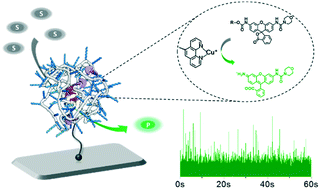当前位置:
X-MOL 学术
›
Mol. Syst. Des. Eng.
›
论文详情
Our official English website, www.x-mol.net, welcomes your
feedback! (Note: you will need to create a separate account there.)
Catalytic single-chain polymeric nanoparticles at work: from ensemble towards single-particle kinetics†
Molecular Systems Design & Engineering ( IF 3.2 ) Pub Date : 2018-06-19 00:00:00 , DOI: 10.1039/c8me00017d Yiliu Liu 1, 2, 3, 4, 5 , Petri Turunen 5, 6, 7, 8, 9 , Bas F. M. de Waal 1, 2, 3, 4, 5 , Kerstin G. Blank 5, 6, 7, 8, 9 , Alan E. Rowan 5, 6, 7, 8, 9 , Anja R. A. Palmans 1, 2, 3, 4, 5 , E. W. Meijer 1, 2, 3, 4, 5
Molecular Systems Design & Engineering ( IF 3.2 ) Pub Date : 2018-06-19 00:00:00 , DOI: 10.1039/c8me00017d Yiliu Liu 1, 2, 3, 4, 5 , Petri Turunen 5, 6, 7, 8, 9 , Bas F. M. de Waal 1, 2, 3, 4, 5 , Kerstin G. Blank 5, 6, 7, 8, 9 , Alan E. Rowan 5, 6, 7, 8, 9 , Anja R. A. Palmans 1, 2, 3, 4, 5 , E. W. Meijer 1, 2, 3, 4, 5
Affiliation

|
Folding a single polymer chain around catalytically active sites to construct catalytic single chain polymeric nanoparticles (SCPNs) is a novel approach to mimic the activity and selectivity of enzymes. In order to relate the efficiency of SCPNs to their three-dimensional structure, a better understanding of their catalytic activity at an individual level, rather than at an ensemble level, is highly desirable. In this work, we present the design and preparation of catalytic SCPNs and a family of fluorogenic substrates, their characterization at the ensemble level as well as our progress towards analyzing individual SCPNs with single-molecule fluorescence microscopy (SMFM). Firstly, organocopper-based SCPNs together with rhodamine-based fluorogenic substrates were designed and synthesized. The SCPNs catalyze the carbamate cleavage reaction of mono-protected rhodamines, with the dimethylpropargyloxycarbonyl protecting group being cleaved most efficiently. A systematic study focusing on the conditions during catalysis revealed that the ligand acceleration effect as well as the accumulation of substrates and catalytically active sites in SCPNs significantly promote their catalytic performance. Secondly, a streptavidin–biotin based strategy was developed to immobilize the catalytic SCPNs on the surface of glass coverslips. Fluorescence correlation spectroscopy experiments confirmed that the SCPNs remained catalytically active after surface immobilization. Finally, single-SCPN activity measurements were performed. The results qualitatively indicated that fluorescent product molecules were formed as a result of the catalytic reaction and that individual fluorescent product molecules could be detected. So far, no evidence for strongly different behaviors has been observed when comparing individual SCPNs.
中文翻译:

催化型单链聚合物纳米颗粒的工作:从整体到单颗粒动力学†
在催化活性位点周围折叠单个聚合物链以构建催化性单链聚合物纳米颗粒(SCPN)是一种模拟酶的活性和选择性的新颖方法。为了将SCPN的效率与其三维结构相关联,非常需要更好地了解它们在单个级别而不是整体级别的催化活性。在这项工作中,我们介绍了催化性SCPN和一系列荧光底物的设计和制备,在整体水平上的表征以及我们在利用单分子荧光显微镜(SMFM)分析单个SCPN方面的进展。首先,设计并合成了基于有机铜的SCPN和若丹明基的荧光底物。SCPN催化单保护的若丹明的氨基甲酸酯裂解反应,其中二甲基炔丙基氧羰基保护基的裂解效率最高。一项针对催化过程中条件的系统研究表明,SCPN中的配体加速作用以及底物和催化活性位点的积累会显着促进其催化性能。其次,开发了一种基于抗生蛋白链菌素-生物素的策略,将催化性SCPN固定在玻璃盖玻片的表面上。荧光相关光谱实验证实,表面固定后,SCPNs仍具有催化活性。最后,进行了单SCPN活动测量。结果定性地表明,通过催化反应形成了荧光产物分子,并且可以检测到单个的荧光产物分子。到目前为止,在比较单个SCPN时,尚未观察到任何行为存在明显差异的证据。
更新日期:2018-06-19
中文翻译:

催化型单链聚合物纳米颗粒的工作:从整体到单颗粒动力学†
在催化活性位点周围折叠单个聚合物链以构建催化性单链聚合物纳米颗粒(SCPN)是一种模拟酶的活性和选择性的新颖方法。为了将SCPN的效率与其三维结构相关联,非常需要更好地了解它们在单个级别而不是整体级别的催化活性。在这项工作中,我们介绍了催化性SCPN和一系列荧光底物的设计和制备,在整体水平上的表征以及我们在利用单分子荧光显微镜(SMFM)分析单个SCPN方面的进展。首先,设计并合成了基于有机铜的SCPN和若丹明基的荧光底物。SCPN催化单保护的若丹明的氨基甲酸酯裂解反应,其中二甲基炔丙基氧羰基保护基的裂解效率最高。一项针对催化过程中条件的系统研究表明,SCPN中的配体加速作用以及底物和催化活性位点的积累会显着促进其催化性能。其次,开发了一种基于抗生蛋白链菌素-生物素的策略,将催化性SCPN固定在玻璃盖玻片的表面上。荧光相关光谱实验证实,表面固定后,SCPNs仍具有催化活性。最后,进行了单SCPN活动测量。结果定性地表明,通过催化反应形成了荧光产物分子,并且可以检测到单个的荧光产物分子。到目前为止,在比较单个SCPN时,尚未观察到任何行为存在明显差异的证据。











































 京公网安备 11010802027423号
京公网安备 11010802027423号